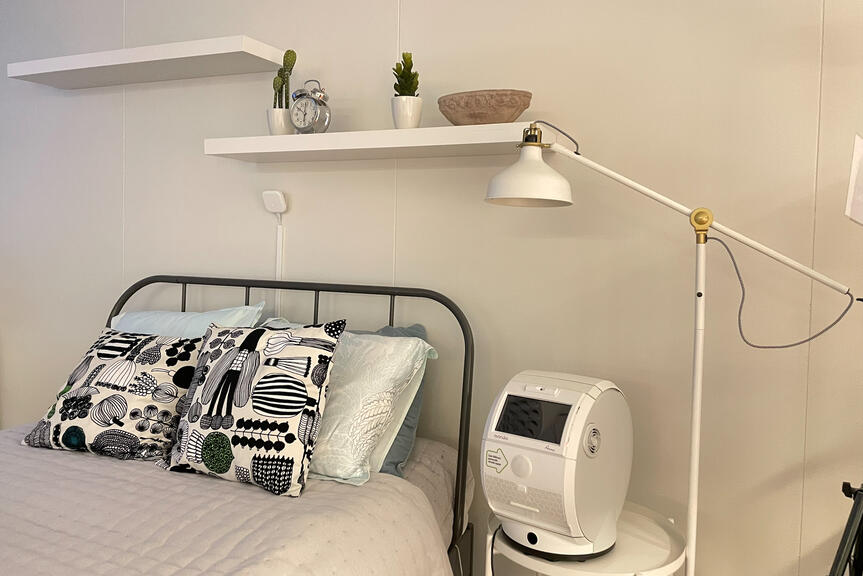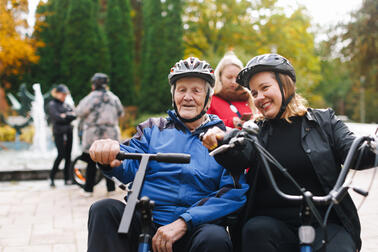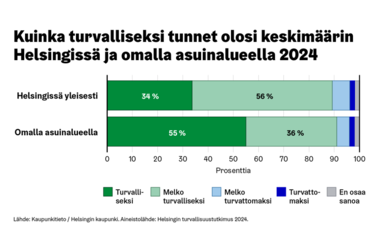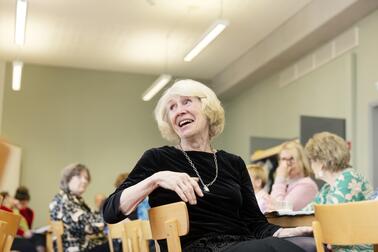
For the duration of the pilot period, five home care clients have had safety systems that utilise radio wave sensors installed in their homes. When the system detects a fall, for example, it automatically alerts Palvelukeskus Helsinki’s security telephone service so that a health care professional can assess the client’s need for care in real time.
“It is not always possible for a security telephone service client to press the alarm button themself if they have forgotten to wear their safety bracelet or lose consciousness when they fall, for example. These are the kinds of situations that we are seeking solutions to with radio wave technology. When our security telephone service receives an alert, the person who has fallen can be provided with help quickly,” says System Designer Jenni Hautojärvi from Palvelukeskus Helsinki, who is serving as the project manager of the pilot project.
Risk assessment can prevent falls
Another important aim of the project is to predict increases in a client's risk of falling with the help of sensors in order to prevent falls in the future.
“The aim is to forecast the risk of falling by observing the client’s level of activity at home, for example. Reduced activity can be a sign of deteriorating general condition or health and increased risk of falling. Two of the participating clients have also had vital sign sensors installed on their beds that collect data on sleep quality, among other things,” Hautojärvi clarifies.
The collected data can help assess whether the client needs additional support or care, for example.
“If we find that falls occur in a particular room or a specific part of the client’s home, we can reduce the risk of falling through targeted preventive measures, such as grab rails, aid devices or home alterations, for example. The risk of falling can also be reduced by supporting the client's functional capacity,” says Planner Ville Ventovuori
More detailed specifications
Palvelukeskus Helsinki tested similar technology to detect falls using the products of a different sensor provider in a pilot project carried out in late 2022/early 2023. The sensors used in that solution were found to be too sensitive, causing a significant number of false alarms.
“We analysed and collected all the important lessons from the previous pilot with Suomen Digitaalinen tehdas Oy in preparation for this pilot. This time, we prepared more detailed specifications at the deployment stage, paying particular attention to the sensitivity of the sensors. Our partners also tested the sensitivity of the sensors in a home environment before the start of the pilot,” says Hautojärvi.
The pilot project being carried out now utilises a fall sensor solution provided Digitaalinen Tehdas Oy and developed by inlisol Oy. Palvelukeskus Helsinki wanted to test sensors based on radio waves again because the technology is currently considered the best solution for fall detection at home in terms of privacy, among other things.
“Wearable safety devices can be easy to forget to put on and many people are not very keen on having cameras inside their home, for example. As a result, a solution based on radio wave technology is seen as the best option in terms of privacy,” Hautojärvi explains.
The pilot is part of the EU-funded CommuniCity project, which involves utilising technologies to develop better services for marginalised communities. The implementation of the project in Helsinki is coordinated by Forum Virium Helsinki.
The current pilot period is planned to last approximately three months. The success of the pilot and the effectiveness of the technological solution during the period will be evaluated by Palvelukeskus Helsinki. The solution will also be studied at Tampere University during the pilot period.The purpose of the study is to examine the potential applications of the fall sensor technology and the experiences and possibilities of professionals and clients in regard to fall prevention.


